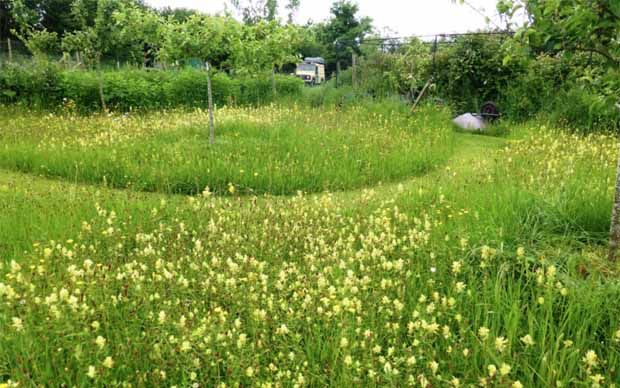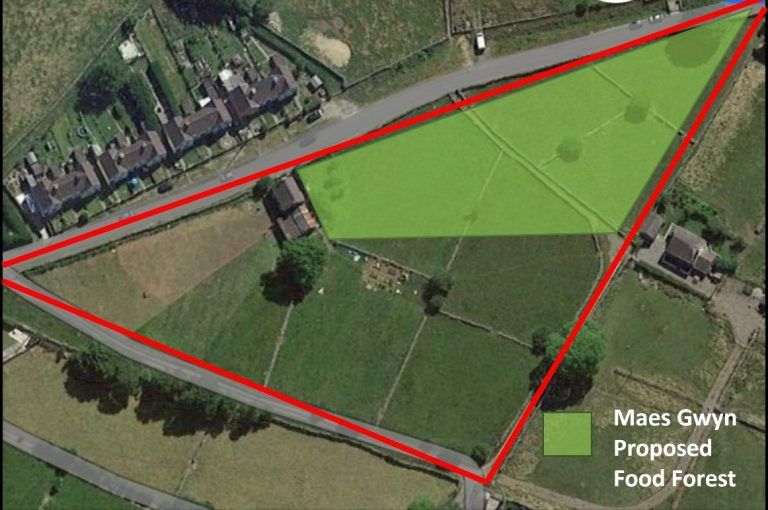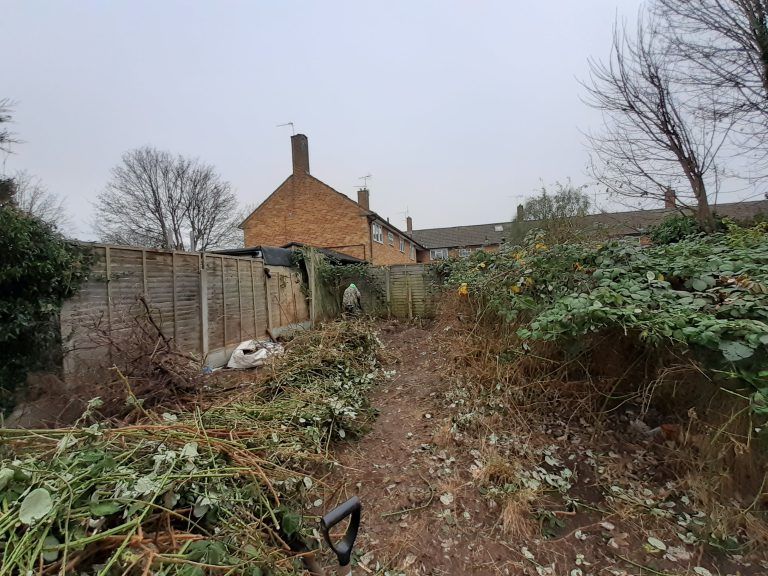Two PFAF trustees, Wendy Stayte and Chris Marsh, visited the site of Incredible Vegetables (www.incrediblevegetables.co.uk ) on 30 May 2017. This is their report of the visit, illustrated largely by photos taken at the time by David Gearing, with additional photos by Mandy Barber.

The Incredible Vegetables (IV) site is 5 ½ acres just outside Ashburton, maintained by Mandy Barber and her partner Julien Skinner, with an adjacent forest garden run by co-owners of the site. Incredible Vegetables is an experimental growing space and fledgling perennial vegetable nursery and Mandy and Julien have a particular interest in perennial vegetables and ‘edimentals’, plants that are both ornamental and edible. It is approached by a steep winding lane, and once reached , commands a view over rolling hills and fields. At this time of year the overwhelming feel of the place is one of great abundance and beauty, with clumps of colourful flowers interspersed among the vegetables and fruit bushes.
The plot enables Mandy and Julien to be self-sufficient in fruit and vegetables all the year round, and also to experiment with growing perennials and an online shop with the aim of providing unusual edible plants and hard to come by perennial vegetables. The sales bring in a small income but not enough to live on. They are continually researching and growing new plants and seek to maximise the numbers of species they can show visitors by creating a diverse edible garden. Mandy also gives talks, with one recently as part of a horticultural course. Mandy presented Incredible Vegetables at the South West Regional Permaculture Convergence on 9-11 June 2017, which Chris also attended. On our mention of PFAF having been started by a group of vegans, Mandy said they are not vegan themselves and do keep chickens alongside the vegetable garden. We admired the gorgeous free range happy chickens around the site providing eggs and entertainment. Mandy also mentioned that they have some perennial kale plants which came from the PFAF site in Cornwall via Carol Wellwood.


We noted at the start of our tour the fencing around the growing area which  protects against deer and rabbits. There are also many support structures for climbing plants, and fruit cages. There are paths and edges to beds but no permanent hoses to water the plants, as the policy is to leave the outdoor plants to adjust for themselves and find their own water. Only in a long and severe drought would they water the crops. There is mains water on site, and a natural reservoir has been excavated to capture rainwater in future years. The site uses organic no-dig methods. Compost is largely from their own veg waste, with some brought-in manure composted down for 3 years. They also use coffee chaff (not grounds). They have to buy in peat-free fine grade compost for small seed sowing.
protects against deer and rabbits. There are also many support structures for climbing plants, and fruit cages. There are paths and edges to beds but no permanent hoses to water the plants, as the policy is to leave the outdoor plants to adjust for themselves and find their own water. Only in a long and severe drought would they water the crops. There is mains water on site, and a natural reservoir has been excavated to capture rainwater in future years. The site uses organic no-dig methods. Compost is largely from their own veg waste, with some brought-in manure composted down for 3 years. They also use coffee chaff (not grounds). They have to buy in peat-free fine grade compost for small seed sowing.
The first growing bed we were shown had small Ulluco plants ( Ullucus tuberosus). These produce small potato-like tubers in many bright and surprising colours tasting like a mixture of beetroot and potato, the leaves and tubers are edible, and the plants produce dense ground cover. Ulluco originates from high in the Andes, where it is an important food crop. It requires 7 months growing for a decent yield. At IV they save the best tubers each year and sprout them in trays initially in the polytunnel, then plant out at the end of May.  A crop of tubers is harvested in December. Ulluco is difficult to grow in the UK because tuber production is triggered by the Autumn equinox and shorter days giving the plants a relatively short space of time before frosts hit to produce a yield. However starting them off undercover in March and then protecting with fleece in winter helps extend the growing period. In Devon it is mild, giving up to 4 more weeks growing time compared to elsewhere in the country. These are treated as annual plants and IV rotate them in the same way as a potato crop.
A crop of tubers is harvested in December. Ulluco is difficult to grow in the UK because tuber production is triggered by the Autumn equinox and shorter days giving the plants a relatively short space of time before frosts hit to produce a yield. However starting them off undercover in March and then protecting with fleece in winter helps extend the growing period. In Devon it is mild, giving up to 4 more weeks growing time compared to elsewhere in the country. These are treated as annual plants and IV rotate them in the same way as a potato crop.
At the end of the Ulluco bed was a row of Mashua plants ( Tropaeolum Tuberosum), which are related to garden nasturtiums. The leaves, flowers and tubers are edible.
 Mandy and Julien are experimenting with growing sweet potatoes outside this year. We saw sweet potatoes planted through holes in a re-cycled polytunnel cover for heat as they need roots in warm soil. There are wells in the plastic sheeting around each plant to collect rain water and channel it down to the plants. The idea for using polytunnel sheeting is that it acts like a glass window on the soil keeping it at a constant high temperature. The high grade sheeting can be used for many years for subsequent crops.
Mandy and Julien are experimenting with growing sweet potatoes outside this year. We saw sweet potatoes planted through holes in a re-cycled polytunnel cover for heat as they need roots in warm soil. There are wells in the plastic sheeting around each plant to collect rain water and channel it down to the plants. The idea for using polytunnel sheeting is that it acts like a glass window on the soil keeping it at a constant high temperature. The high grade sheeting can be used for many years for subsequent crops.
 Next we saw Allium proliferum – an attractive hardy perennial spring onion type plants with clusters of aerial onions which bend over and replant themselves, also called ‘walking onions’ or ‘Tree Onions’. They can be used as a perennial spring onion and the little aerial onions are delicious too.
Next we saw Allium proliferum – an attractive hardy perennial spring onion type plants with clusters of aerial onions which bend over and replant themselves, also called ‘walking onions’ or ‘Tree Onions’. They can be used as a perennial spring onion and the little aerial onions are delicious too.
 We saw a small pond where there are frogs and newts. Wendy mentioned that newts can attack tadpoles but we were told they seem to coexist here. The frogs, and the toads elsewhere on site, protect against slugs and snails. IV also use coarse horticultural sand around delicate plants to deter slugs.
We saw a small pond where there are frogs and newts. Wendy mentioned that newts can attack tadpoles but we were told they seem to coexist here. The frogs, and the toads elsewhere on site, protect against slugs and snails. IV also use coarse horticultural sand around delicate plants to deter slugs.
 The next plant we were shown was Hablitzia Tamnoides a perennial climbing spinach, also known as Caucasian spinach which Mandy told us is ‘hottest thing in perennial growing’, brought to the world’s attention by Author Stephen Barstow in his book ‘Around the World in 80 Plants’. Its fame has grown through social media and people all over the world are beginning to recognise it as a very important permaculture plant. It even has its own Facebook group! It grows to 8-10 feet in semi-shade and is hardy down to about -25%C. Young shoots in spring are good to eat and the leaves can be harvested from March to July. They have a mild taste and are cooked like spinach or eaten raw in a salad. The plant has delicate white flowers which can also be eaten as they emerge.
The next plant we were shown was Hablitzia Tamnoides a perennial climbing spinach, also known as Caucasian spinach which Mandy told us is ‘hottest thing in perennial growing’, brought to the world’s attention by Author Stephen Barstow in his book ‘Around the World in 80 Plants’. Its fame has grown through social media and people all over the world are beginning to recognise it as a very important permaculture plant. It even has its own Facebook group! It grows to 8-10 feet in semi-shade and is hardy down to about -25%C. Young shoots in spring are good to eat and the leaves can be harvested from March to July. They have a mild taste and are cooked like spinach or eaten raw in a salad. The plant has delicate white flowers which can also be eaten as they emerge.
Mandy described it as a ‘triffid’!
 The next plant we were shown was ‘Panache’ Daubenton’s kale ( Brassica Oleracea var. Ramosa) a variegated perennial kale which grows for 4-5 years. The plants do flower occasionally but can be easily propagated by cuttings,
The next plant we were shown was ‘Panache’ Daubenton’s kale ( Brassica Oleracea var. Ramosa) a variegated perennial kale which grows for 4-5 years. The plants do flower occasionally but can be easily propagated by cuttings,
 We saw some Good King Henry ( Blitum Bonus-Henricus). Wendy said she dislikes the taste and Mandy suggested steeping it in salt water for half and hour, rinsing them and then to sauté the leaves.
We saw some Good King Henry ( Blitum Bonus-Henricus). Wendy said she dislikes the taste and Mandy suggested steeping it in salt water for half and hour, rinsing them and then to sauté the leaves.

Next we saw Myrtus Ugni plant – Also called Chilean guava, which have fruit like small cranberries and tasting remarkably of strawberries and bubblegum. The fruits are harvested in early winter.
We saw another perennial loose leafed cabbage, with no name, originally from Ken Fern’s garden.

We saw Japanese wine berries ( Rubus Phoenicolasius), Tayberry and Loganberry.
 Next was Apios Americana or Hopniss, Indian potato. It is an attractive climbing perennial vine with edible beans and large edible tubers native to parts of North America. Mandy grows it in bottomless pots to allow the plants to draw nutrients from the soil but at the same time make harvesting easier as most of the tubers cluster in the pots. It produces a ‘bead necklace’ of edible tubers which when roasted have a taste akin to chestnut and sweet potato.
Next was Apios Americana or Hopniss, Indian potato. It is an attractive climbing perennial vine with edible beans and large edible tubers native to parts of North America. Mandy grows it in bottomless pots to allow the plants to draw nutrients from the soil but at the same time make harvesting easier as most of the tubers cluster in the pots. It produces a ‘bead necklace’ of edible tubers which when roasted have a taste akin to chestnut and sweet potato.
 Next was Skirret ( Sium Sisarum), a perennial root vegetable with a cluster of skinny sweet parsnip type roots. You can force emerging shoots with a pot for an early spring delicacy. It grows 7-8 foot tall in summer with umbels of delicate white flowers beneficial for hover flies. To eat skirret, the roots need a good scrub and are nice raw or in a stew, or pan fried with herbs and can be used as a thickening agent. Skirret’s heyday was in 17-18C before potatoes stole the show. Skirret is grown as an historical vegetable at Hampton Court as part of their Tudor vegetable garden.
Next was Skirret ( Sium Sisarum), a perennial root vegetable with a cluster of skinny sweet parsnip type roots. You can force emerging shoots with a pot for an early spring delicacy. It grows 7-8 foot tall in summer with umbels of delicate white flowers beneficial for hover flies. To eat skirret, the roots need a good scrub and are nice raw or in a stew, or pan fried with herbs and can be used as a thickening agent. Skirret’s heyday was in 17-18C before potatoes stole the show. Skirret is grown as an historical vegetable at Hampton Court as part of their Tudor vegetable garden.
 Next we saw Taunton Deane Perennial kale ( Brassica Oleracea var. Acephala) originally from the Taunton Deane area in Somerset. An amazing plant providing delicious tender greens all year, growing up to 7ft tall in sheltered spots. Cuttings can be taken from pinched-off stems and take 3-4 weeks to root. IV are considering growing enough to supply locally.
Next we saw Taunton Deane Perennial kale ( Brassica Oleracea var. Acephala) originally from the Taunton Deane area in Somerset. An amazing plant providing delicious tender greens all year, growing up to 7ft tall in sheltered spots. Cuttings can be taken from pinched-off stems and take 3-4 weeks to root. IV are considering growing enough to supply locally.
 We saw another perennial kale (Daubenton’s) sister plant to the ‘Panache’ mentioned above which can live for decades, with talk of plants living for up to 40 years. The Daubenton’s, alongside the Taunton Deane perennial kales have incredible resilience and have acted as amazing companions to the ‘regular’ brassicas grown on site. They attract the pests away from biannual kale plants such as Cavolo Nero, while having the capacity to bounce back in a matter of months These hardy perennial kales grow into such dense bushes they can be used in a row as an edible wind-break.
We saw another perennial kale (Daubenton’s) sister plant to the ‘Panache’ mentioned above which can live for decades, with talk of plants living for up to 40 years. The Daubenton’s, alongside the Taunton Deane perennial kales have incredible resilience and have acted as amazing companions to the ‘regular’ brassicas grown on site. They attract the pests away from biannual kale plants such as Cavolo Nero, while having the capacity to bounce back in a matter of months These hardy perennial kales grow into such dense bushes they can be used in a row as an edible wind-break.
There were Dahlias which IV grow for the flowers to attract bees and some varieties for the edible storage roots.
 Next we saw small plants of Giant Tree Spinach ( Chenopodium Giganteum) with attractive centres of vivid magenta which grow to 6-7 feet tall. These are left to happily self-sow each year and produce a welcome harvest of very colourful salad leaves for many months.
Next we saw small plants of Giant Tree Spinach ( Chenopodium Giganteum) with attractive centres of vivid magenta which grow to 6-7 feet tall. These are left to happily self-sow each year and produce a welcome harvest of very colourful salad leaves for many months.
Then there were a number of hostas, which Mandy told us are edible.
 We were shown Nine Star Perennial Broccoli (Brassica oleracea botrytis asparagoides), which produces white cauliflower florets, and when you cut these off, it produces several satellite heads – hence the name. Providing all the florets are harvested and the plants are not allowed to flower it will survive for up to 5 years producing a crop each subsequent spring. It was developed by Curtis in Cambridge the 1920’s and up until fairly recently the seeds could be obtained quite easily. Sadly over the last few years producers have dwindled and only a handful of small growers still cultivate it and Nine Star is becoming very scarce.
We were shown Nine Star Perennial Broccoli (Brassica oleracea botrytis asparagoides), which produces white cauliflower florets, and when you cut these off, it produces several satellite heads – hence the name. Providing all the florets are harvested and the plants are not allowed to flower it will survive for up to 5 years producing a crop each subsequent spring. It was developed by Curtis in Cambridge the 1920’s and up until fairly recently the seeds could be obtained quite easily. Sadly over the last few years producers have dwindled and only a handful of small growers still cultivate it and Nine Star is becoming very scarce.
IV hope to get grant funding for a 10 year project to develop and improve the crop and produce their own seed. They have set aside space on site which is currently under an agricultural ground cover mulch.
 Next we saw Chinese Artichokes (Stachys Affinis)] which produces a prolific and useful winter crop of crunchy tubers for harvest between October to March.
Next we saw Chinese Artichokes (Stachys Affinis)] which produces a prolific and useful winter crop of crunchy tubers for harvest between October to March.
 Then Sea Kale ( Crambe Maritima), the early shoots can be forced an eaten as a delicacy like an asparagus spear. The small broccoli like florets can be eaten too, as well as the leaves and flowers. The flowers are very perfumed with a gorgeous honey like scent.
Then Sea Kale ( Crambe Maritima), the early shoots can be forced an eaten as a delicacy like an asparagus spear. The small broccoli like florets can be eaten too, as well as the leaves and flowers. The flowers are very perfumed with a gorgeous honey like scent.

Next was Cardoon (Cyanara Cardunculus) with stems like huge celery sticks. The stems are wrapped in sacking in the autumn for about 4 weeks to blanch and tenderise them before harvesting.
 After that we came to a giant rhubarb plant, so huge it might have been a Gunnera Manicata, but it had masses of enormous edible stems – and we took some home.
After that we came to a giant rhubarb plant, so huge it might have been a Gunnera Manicata, but it had masses of enormous edible stems – and we took some home.
 Next was Potato Onion (Allium Cepa Aggregatum group), which produce small onions in a similar way to shallots. The green tops can be harvested like a spring onion and the plants can be left in the ground over a number of years or alternatively treated as an annual, harvesting and storing onions to eat and some for re-planting.
Next was Potato Onion (Allium Cepa Aggregatum group), which produce small onions in a similar way to shallots. The green tops can be harvested like a spring onion and the plants can be left in the ground over a number of years or alternatively treated as an annual, harvesting and storing onions to eat and some for re-planting.
 Then Babington Leeks ( Allium Ampeloprasum var. Babingtonii) [which we saw in Ken’s garden]. Delicious slender perennial leeks with a hit of garlic, which can be left to colonise an area and can be cut at the base for eating and left to re-grow the following year.
Then Babington Leeks ( Allium Ampeloprasum var. Babingtonii) [which we saw in Ken’s garden]. Delicious slender perennial leeks with a hit of garlic, which can be left to colonise an area and can be cut at the base for eating and left to re-grow the following year.

Then we had a tour of the polytunnel. There were: Cucamelons – (Melothria Scabra) grape-sized cucumbers with the added benefit that they can be treated as a perennial by storing the roots over winter. Chufa, (Cyperus Esculentus) Tiger Nut, Earth Almond, of the sedge family, needs a long hot summer to produce well. Purple Tree Collards which are difficult to get hold of in this country.

Madeira Vines rampant in tropics, but being frost tender can be grown as a useful edible leaf in the UK, used as spinach and a relative of Ulluco mentioned above. Sweet Potatoes – regular and Molokai purple; Broad beans – in the polytunnel to get an early crop; Vietnamese coriander ( Persicaria Odorata), strong and tasty;
 Udo, (Aralia Cordata), a baby now but grows to into a majestic plant, popular in Japan as an edible veg.
Udo, (Aralia Cordata), a baby now but grows to into a majestic plant, popular in Japan as an edible veg.
 Emerging from the polytunnel we saw a big patch of yellow rattle, a pretty wild flower, in the small meadow around some fruit trees.
Emerging from the polytunnel we saw a big patch of yellow rattle, a pretty wild flower, in the small meadow around some fruit trees.
We were deeply inspired both by the range of unusual perennial plants on this site, and the devotion and passion of Mandy Barber who has created such a Garden of Eden on a south Devon hilltop.

Our visit concluded with an alfresco lunch including homemade bread and a salad of habitzia leaves, eaten on rustic benches around the fire pit.
Use the Cube solver program to calculate the solution for your unsolved Rubik’s Cube.







